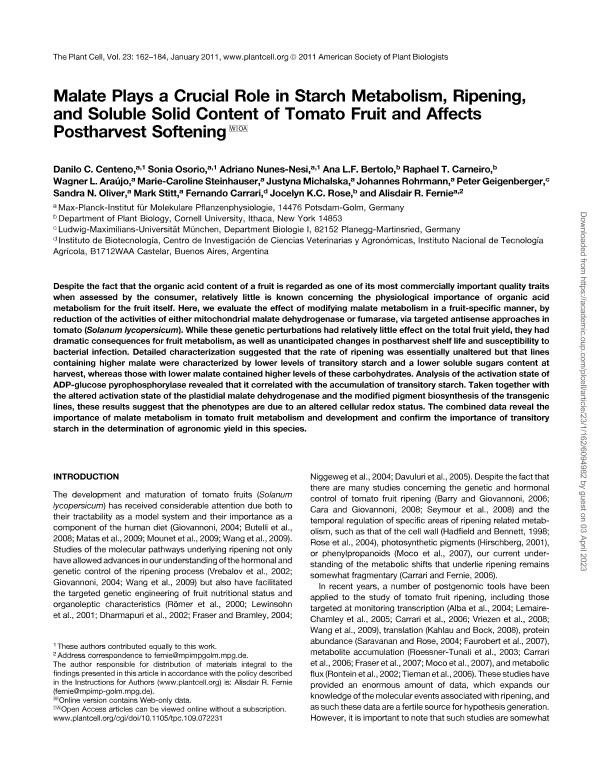Mostrar el registro sencillo del ítem
dc.contributor.author
Centeno, Danilo C.
dc.contributor.author
Osorio, Sonia
dc.contributor.author
Nunes Nesi, Adriano
dc.contributor.author
Bertolo, Ana L. F.
dc.contributor.author
Carneiro, Raphael T.
dc.contributor.author
Araújo, Wagner L.
dc.contributor.author
Steinhauser, Marie Caroline
dc.contributor.author
Michalska, Justyna
dc.contributor.author
Rohrmann, Johannes
dc.contributor.author
Geigenberger, Peter
dc.contributor.author
Oliver, Sandra N.
dc.contributor.author
Stitt, Mark
dc.contributor.author
Carrari, Fernando Oscar

dc.contributor.author
Rose, Jocelyn K. C.
dc.contributor.author
Fernie, Alisdair R.
dc.date.available
2023-04-03T11:32:06Z
dc.date.issued
2011-03
dc.identifier.citation
Centeno, Danilo C.; Osorio, Sonia; Nunes Nesi, Adriano; Bertolo, Ana L. F.; Carneiro, Raphael T.; et al.; Malate plays a crucial role in starch metabolism, ripening, and soluble solid content of tomato fruit and affects postharvest softening; American Society of Plant Biologist; Plant Cell; 23; 1; 3-2011; 162-184
dc.identifier.issn
1040-4651
dc.identifier.uri
http://hdl.handle.net/11336/192404
dc.description.abstract
Despite the fact that the organic acid content of a fruit is regarded as one of its most commercially important quality traits when assessed by the consumer, relatively little is known concerning the physiological importance of organic acid metabolism for the fruit itself. Here, we evaluate the effect of modifying malate metabolism in a fruit-specific manner, by reduction of the activities of either mitochondrial malate dehydrogenase or fumarase, via targeted antisense approaches in tomato (Solanum lycopersicum). While these genetic perturbations had relatively little effect on the total fruit yield, they had dramatic consequences for fruit metabolism, as well as unanticipated changes in postharvest shelf life and susceptibility to bacterial infection. Detailed characterization suggested that the rate of ripening was essentially unaltered but that lines containing higher malate were characterized by lower levels of transitory starch and a lower soluble sugars content at harvest, whereas those with lower malate contained higher levels of these carbohydrates. Analysis of the activation state of ADP-glucose pyrophosphorylase revealed that it correlated with the accumulation of transitory starch. Taken together with the altered activation state of the plastidial malate dehydrogenase and the modified pigment biosynthesis of the transgenic lines, these results suggest that the phenotypes are due to an altered cellular redox status. The combined data reveal the importance of malate metabolism in tomato fruit metabolism and development and confirm the importance of transitory starch in the determination of agronomic yield in this species.
dc.format
application/pdf
dc.language.iso
eng
dc.publisher
American Society of Plant Biologist

dc.rights
info:eu-repo/semantics/openAccess
dc.rights.uri
https://creativecommons.org/licenses/by-nc-sa/2.5/ar/
dc.subject
tomato
dc.subject
Solanum
dc.subject
post-harvest
dc.subject
metabolism
dc.subject.classification
Bioquímica y Biología Molecular

dc.subject.classification
Ciencias Biológicas

dc.subject.classification
CIENCIAS NATURALES Y EXACTAS

dc.title
Malate plays a crucial role in starch metabolism, ripening, and soluble solid content of tomato fruit and affects postharvest softening
dc.type
info:eu-repo/semantics/article
dc.type
info:ar-repo/semantics/artículo
dc.type
info:eu-repo/semantics/publishedVersion
dc.date.updated
2023-03-28T14:26:57Z
dc.journal.volume
23
dc.journal.number
1
dc.journal.pagination
162-184
dc.journal.pais
Estados Unidos

dc.description.fil
Fil: Centeno, Danilo C.. Max Planck Institute Of Molecular Plant Physiology; Alemania
dc.description.fil
Fil: Osorio, Sonia. Max Planck Institute Of Molecular Plant Physiology; Alemania
dc.description.fil
Fil: Nunes Nesi, Adriano. Max Planck Institute Of Molecular Plant Physiology; Alemania
dc.description.fil
Fil: Bertolo, Ana L. F.. Cornell University; Estados Unidos
dc.description.fil
Fil: Carneiro, Raphael T.. Cornell University; Estados Unidos
dc.description.fil
Fil: Araújo, Wagner L.. Max Planck Institute Of Molecular Plant Physiology; Alemania
dc.description.fil
Fil: Steinhauser, Marie Caroline. Max Planck Institute Of Molecular Plant Physiology; Alemania
dc.description.fil
Fil: Michalska, Justyna. Max Planck Institute Of Molecular Plant Physiology; Alemania
dc.description.fil
Fil: Rohrmann, Johannes. Max Planck Institute Of Molecular Plant Physiology; Alemania
dc.description.fil
Fil: Geigenberger, Peter. Technische Universitat München; Alemania
dc.description.fil
Fil: Oliver, Sandra N.. Max Planck Institute Of Molecular Plant Physiology; Alemania
dc.description.fil
Fil: Stitt, Mark. Max Planck Institute Of Molecular Plant Physiology; Alemania
dc.description.fil
Fil: Carrari, Fernando Oscar. Instituto Nacional de Tecnología Agropecuaria. Centro de Investigación en Ciencias Veterinarias y Agronómicas. Instituto de Biotecnología; Argentina. Consejo Nacional de Investigaciones Científicas y Técnicas; Argentina
dc.description.fil
Fil: Rose, Jocelyn K. C.. Cornell University; Estados Unidos
dc.description.fil
Fil: Fernie, Alisdair R.. Max Planck Institute Of Molecular Plant Physiology; Alemania
dc.journal.title
Plant Cell

dc.relation.alternativeid
info:eu-repo/semantics/altIdentifier/url/https://academic.oup.com/plcell/article/23/1/162/6094982
dc.relation.alternativeid
info:eu-repo/semantics/altIdentifier/doi/http://dx.doi.org/10.1105/tpc.109.072231
Archivos asociados
